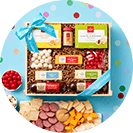-
Gift Baskets
-
View All Categories
- Best Sellers
- Wine Gift Baskets
- Gift Boxes
- Gift Towers
- Charcuterie Gifts
- Sweet & Savory Gifts
- New!
- Sale
Shop by Category
- Valentine's Day
- Birthday
- Thank You
- Congratulations
- Sympathy Gifts
- Gifts Under $30
- Gifts Under $50
- Gifts Under $100
Occasions
Shop By Price
Meat & Cheese
-
View All Categories
- Meat & Cheese Gifts
- Beef Summer Sausage
- Turkey Summer Sausage
- Dry Salami
- Gluten Free
- Sale
Shop by Category
Most Popular
Wine Gifts
-
View All Categories
- Wine Gift Baskets
- Champagne Gift Baskets
- Red Wine Gift Baskets
- Chardonnay Gift Baskets
- Rosé Gift Baskets
- White Wine Gift Baskets
- Wine Bottle Gift Boxes
- Sale
Shop by Category
- Christmas Wine Gifts
- Birthday Wine Gifts
- Luxury Gift Baskets
Shop by Occasion
Most Popular
Holiday
Occasions
-
View All Categories
- Birthday Gifts
- Sympathy Baskets
- Thank You Gifts
- Congratulations Gift Baskets
- Thinking of You
- Get Well
- Last Minute Gifts
Shop by Category
- Game Day Gifts
- Date Night
- Gifts for Her
- Gifts for Him
- Anniversary
- New Baby
- Wedding & Engagement
- Retirement Gifts
Shop by Occasion
Most Popular
Snacks
Cupcakes
Corporate Gifts
-
View All Categories
- Corporate Holiday Gifts
- Corporate Gift Baskets
Shop by Category









